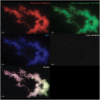Acute Septic Arthritis of the Knee Caused by Kingella kingae in a 5-Year-Old Cameroonian Boy
- PMID: 29164082
- PMCID: PMC5681518
- DOI: 10.3389/fped.2017.00230
Acute Septic Arthritis of the Knee Caused by Kingella kingae in a 5-Year-Old Cameroonian Boy
Abstract
Kingella kingae is an important cause of invasive infections in young children from Western countries. Although increasing reports indicate that this organism is the leading agent of bone and joint infections in early childhood, data on K. kingae infections from resource-limited settings are scarce, and none has yet been reported in Africa. We herein report the diagnostic and epidemiological investigations of the first case of K. kingae arthritis identified in a child from sub-Saharan Africa. A 5-year-old Cameroonian boy presented with a sudden painful limp which appeared in the course of a mild rhinopharyngitis. He lived in Cameroon where he had been vaccinated with BCG at birth and moved to France for holidays 4 days before consultation. There was no history of trauma and he did not have any underlying medical condition. Upon admission, he had a temperature of 36.7°C, and clinical examination revealed right-sided knee tenderness and effusion that was confirmed by ultrasound imaging. Laboratory results showed a white blood cell count of 5,700 cells/mm3, C-reactive protein level of 174 mg/L, and platelet count of 495,000 cells/mm3. He underwent an arthrocentesis and was immediately given intravenous amoxicillin-clavulanate. Conventional cultures from blood samples and synovial fluids were negative. Polymerase chain reaction (PCR) assay targeting the broad-range 16S rRNA gene and real-time quantitative PCR assays targeting Mycobacterium species were negative. Surprisingly, real-time PCR assays targeting the cpn60, rtxA, and rtxB genes of K. kingae were positive. Multicolor fluorescence in situ hybridization specific for K. kingae identified the presence of numerous coccobacilli located within the synovial fluid. Finally, multilocus sequence typing analysis performed on deoxyribonucleic acid directly extracted from joint fluid disclosed a novel K. kingae sequence-type complex. This case report demonstrates that K. kingae may be considered as a potential cause of septic arthritis in children living in sub-Saharan Africa, and hence the burden of K. kingae infection may be not limited to the Western countries. Further studies are required to determine the prevalence of K. kingae infection and carriage in Africa.
Keywords: Africa South of the Sahara; Kingella kingae; arthritis; infectious; multilocus sequence typing; pediatrics.
Figures

Similar articles
-
Evaluation of dual target-specific real-time PCR for the detection of Kingella kingae in a Danish paediatric population.Infect Dis (Lond). 2018 Mar;50(3):200-206. doi: 10.1080/23744235.2017.1376254. Epub 2017 Sep 15. Infect Dis (Lond). 2018. PMID: 28914110
-
Molecular Tests That Target the RTX Locus Do Not Distinguish between Kingella kingae and the Recently Described Kingella negevensis Species.J Clin Microbiol. 2017 Oct;55(10):3113-3122. doi: 10.1128/JCM.00736-17. Epub 2017 Aug 9. J Clin Microbiol. 2017. PMID: 28794176 Free PMC article.
-
Kingella kingae septic arthritis in children: recognising an elusive pathogen.J Child Orthop. 2014 Feb;8(1):91-5. doi: 10.1007/s11832-014-0549-4. Epub 2014 Jan 23. J Child Orthop. 2014. PMID: 24488842 Free PMC article.
-
Systematic Review of Kingella kingae Musculoskeletal Infection in Children: Epidemiology, Impact and Management Strategies.Pediatric Health Med Ther. 2020 Feb 24;11:73-84. doi: 10.2147/PHMT.S217475. eCollection 2020. Pediatric Health Med Ther. 2020. PMID: 32158303 Free PMC article. Review.
-
Diagnosing Kingella kingae infections in infants and young children.Expert Rev Anti Infect Ther. 2017 Oct;15(10):925-934. doi: 10.1080/14787210.2017.1381557. Epub 2017 Sep 22. Expert Rev Anti Infect Ther. 2017. PMID: 28918656 Review.
Cited by
-
First report of Kingella kingae infection in a paediatric population in Accra, Ghana.Pan Afr Med J. 2022 Feb 2;41:95. doi: 10.11604/pamj.2022.41.95.29528. eCollection 2022. Pan Afr Med J. 2022. PMID: 35465371 Free PMC article.
-
Rapid identification of pathogens involved in pediatric osteoarticular infections by multiplex PCR.Ann Transl Med. 2020 Mar;8(5):203. doi: 10.21037/atm.2020.01.34. Ann Transl Med. 2020. PMID: 32309350 Free PMC article.
References
-
- Ceroni D, Llana RA, Kherad O, Dubois-Ferriere V, Lascombes P, Renzi G, et al. Comparing the oropharyngeal colonization density of Kingella kingae between asymptomatic carriers and children with invasive osteoarticular infections. Pediatr Infect Dis J (2013) 32:412–4. 10.1097/INF.0b013e3182846e8f - DOI - PubMed
Publication types
LinkOut - more resources
Full Text Sources
Other Literature Sources
Research Materials

